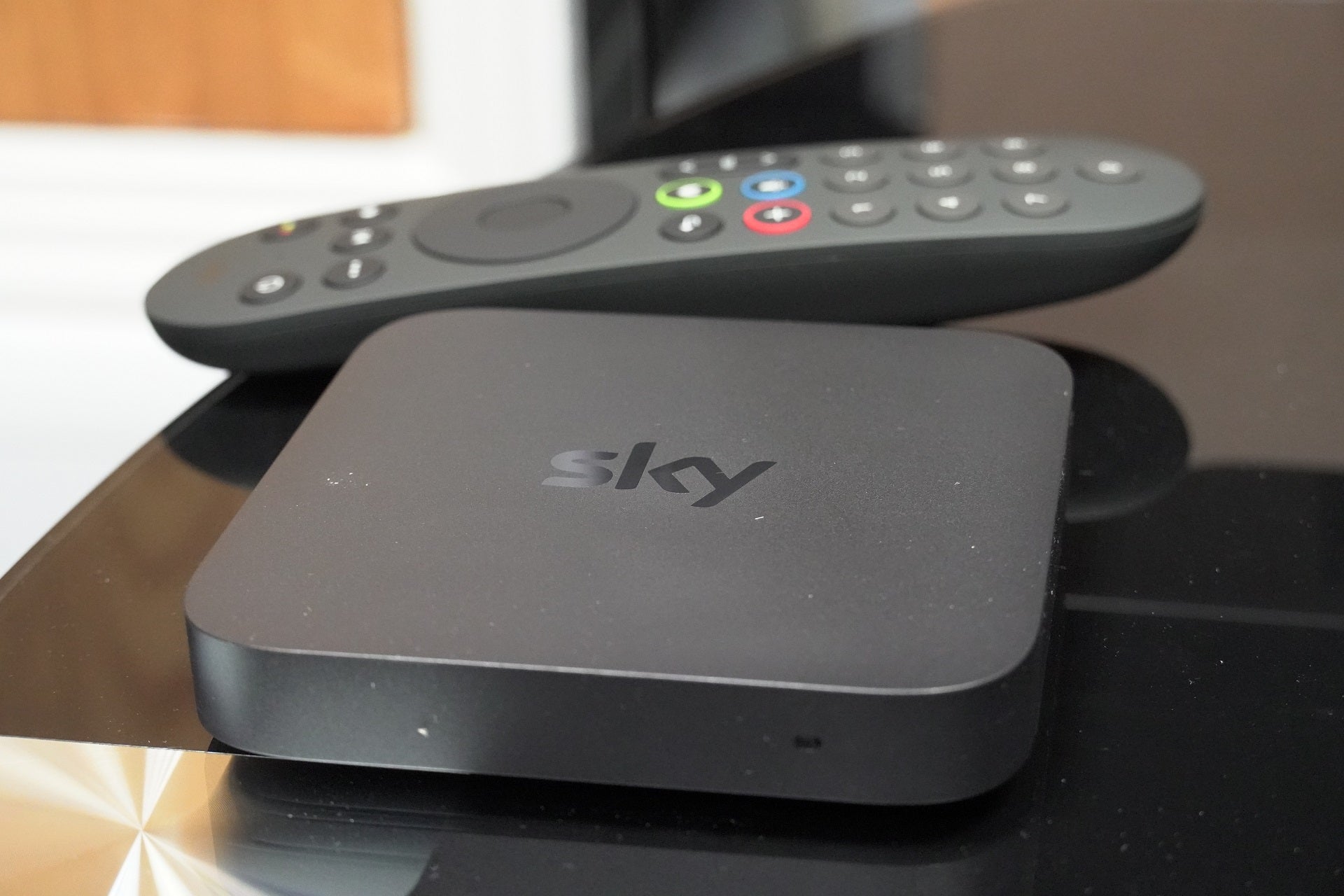Verdict
An excellent premium streamer from Sky that puts content at the core of its offering. That content is pricey, but no other broadcaster offers a broad a church as Sky does with its entertainment options.
Pros
- Democratic approach to content discovery
- Accessible interface
- Dolby Vision and Atmos support
- Stable streaming performance
Cons
- Costs add up with add-ons
- Additional pucks eat up more bandwidth
- Interface is a little sluggish at times
-
HDRHDR10, Dolby Vision and HLG -
Entertainment OSSky’s interface for curating content across services -
AudioDolby Atmos support
Introduction
First it was all about the box beneath your TV screen, then it became an actual TV and now it’s completed another transformation into a puck, with the Sky Stream presented as a standalone streamer.
Initially, the Stream puck was only available as an accessory to the Sky Glass TV, but it’s since been liberated, purchasable on its own and it’s arguably one of the wisest moves Sky has made.
Sky Glass has been a success among more casual TV viewers, but it’s not perfect. With the Stream, it allows customers who don’t need a new TV a ‘just-add’ device, bringing the same content you’d find on Sky Q and Glass in a more accessible and convenient form. It comes with a premium price tag, but if you can afford all the trimmings, this is a great pathway into the world of entertainment Sky offers.
Availability
Offers for Sky Stream change throughout the year. Often, it’s a choice of 18-month contract with prices hovering between £24- and £26/month. That promotion entitles you to the puck, Sky TV and Netflix Basic as standard.
Another option is the ‘flexible’ 31-day rolling contract that can be cancelled at any time. Prices for that tend be higher at £29/month.
As of November 2023, there’s a deal that guarantees a 1-month free trial on both contract terms, and thereafter it bumps up to the usual prices for £26/month on the 18-month and £29/month for the rolling contracts.
You can choose from several bundles on a fixed basis or rolling contract and further modify it with add-on packs and services. For instance, the UHD/Dolby Atmos pack it is a rolling £6/month, TNT Sports is currently £28/month, and Sky Sports is currently £20/month on a 18-month contract.
For the Whole Home pack, it’s an extra £12/month that allows access to five additional Stream devices (the second puck is free). Some bundles have no set-up costs, others incur a £20 set-up fee on an 18-month contract.
Design
- HDMI cable included
- HDMI 2.1 port
- Doesn’t require line of sight for remote
The Sky Stream puck’s black finish and square shape with rounded corners is both a discreet and space saving design. Even more helpful is that it doesn’t require line-of-sight so you could happily place it behind a TV and still operated it.
It looks not unlike the Mi Box S and Strong Leap-S1 in shape and size but has fewer connection options than either. Around the back is an HDMI 2.1 input (a cable is packaged), an Ethernet port and an aerial tuner, the only real use for the latter is as backup for a TV signal if the internet goes down.
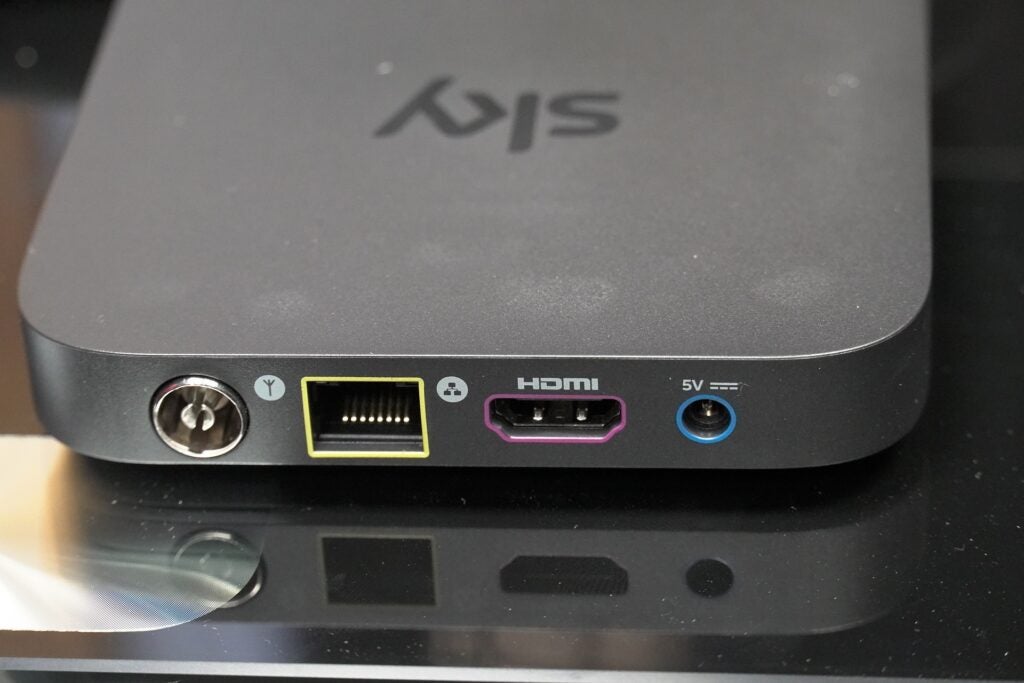
Sky is a closed system and doesn’t offer the connectivity options that Android and (some) Fire TV streamers do. There’s no ability to hook directly to a sound system, connect a hard drive or plug a pair of wired headphones if you so choose. HDMI CEC support means control of volume on a soundbar/TV, and that can be done in the initial set-up process or later in the Stream’s menus.
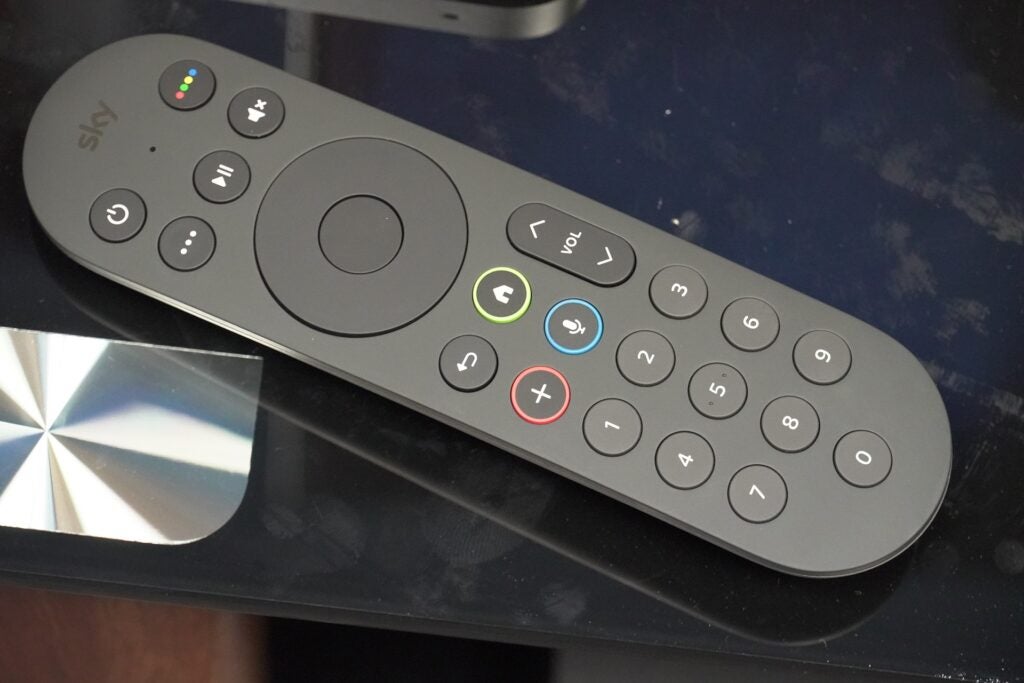
Interface and apps
- Smaller selection of apps compared to Fire TV, Roku
- Seamless resumption across multiple pucks
- Coherent and well-laid out interface
Sky calls the interface for both its Stream and Glass devices ‘Entertainment OS’. It aggregates all of Sky’s content alongside that from other providers such as BBC iPlayer, Netflix and Disney+. I find it a much more democratic interface than Amazon’s Fire TV as it doesn’t outright favour Sky over others.
At the top of the screen are Top Picks, followed by a rail divided into sections (Playlist, TV Shows, Movies, Sport, Kids, Audio and Music, News, Fitness and International). Dive into each section and you’ll find content listed in rows and TV guides specific to each one.
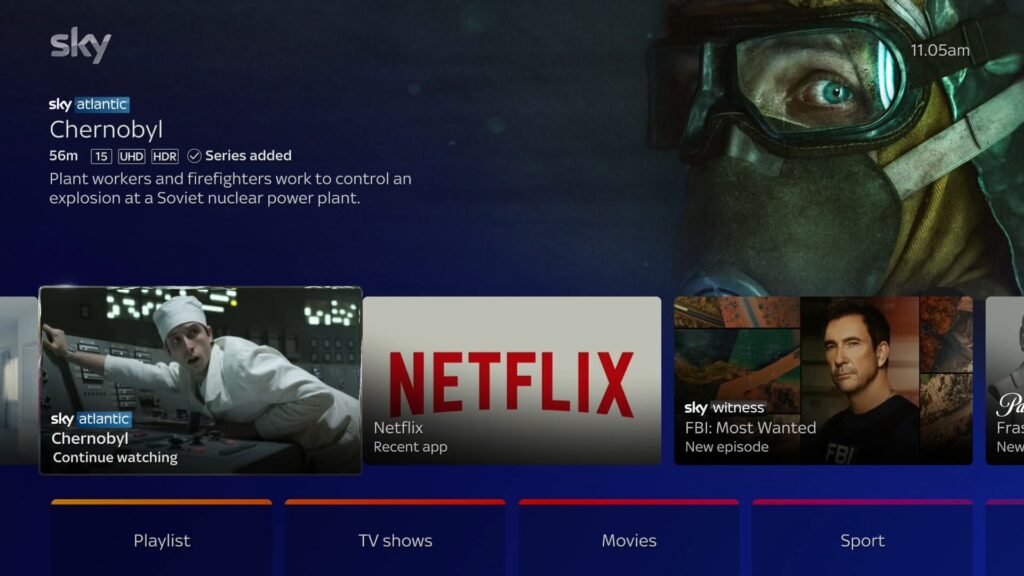
Playlist is ordered by ‘most recent’, so new and current episodes/shows show up first. I’d prefer the Continue Watching rail to be the next one down from Top picks and the content section rails rather than having to scroll down for it, but otherwise the interface is all coherently laid out and easy to grasp with straightforward navigation.
Watch something and return to the home screen and content keeps playing in a pop-up video in the Top Pick rail, so you can return to it without pausing. If you have multiple pucks, content is synchronized so you can jump from your living room to your bedroom, and resume where you left off.
In terms of apps, there isn’t as big a selection as on Android/Google, Roku, or Fire TV, but the argument could be made about quality over quantity. Nevertheless, small apps like Mubi and Curzon aren’t present but all the main UK catch-up apps are present.
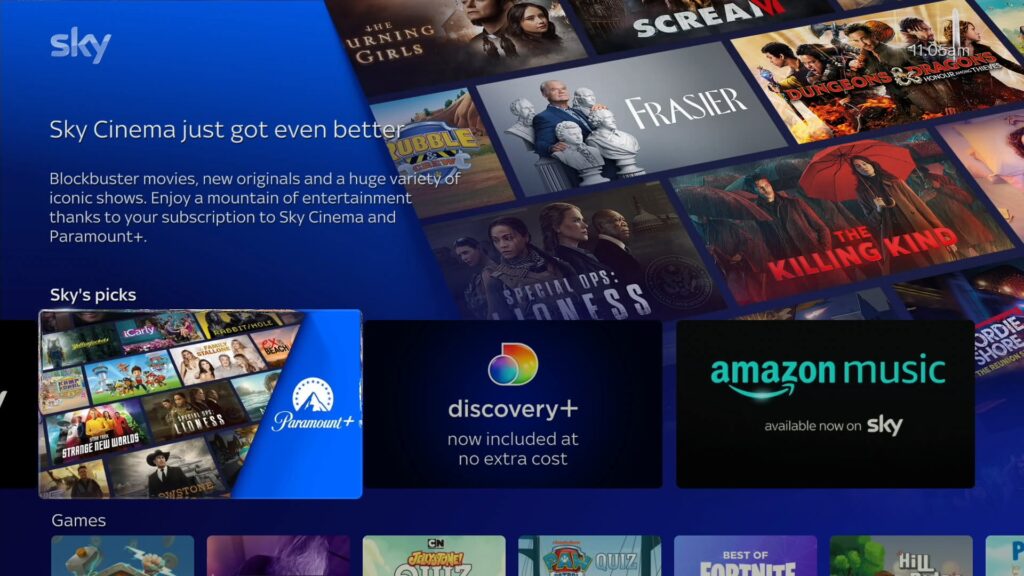
You can count on most of the big, popular apps to be there, as well as ITVX, All4, YouTube, and bulked up by Lionsgate+, Apple TV+, Spotify, Peloton and more. Paramount+, Peacock and Discovery+ are included for those with Sky Cinema and TV subscriptions.
If there’s an obvious area where Sky is missing apps, it’s sports – no individual TNT Sport, UFC, WWE, NFL, or Eurosport apps, though either a Sky Sports or TNT Sports sub would cover these. The other is music, with no Tidal, Deezer or Apple Music.
Unlike Fire TV and Google TV, Sky has opted not to include individual profiles. Instead, up to five ‘personal’ playlists can be created, acting as ‘profiles’ for family members.
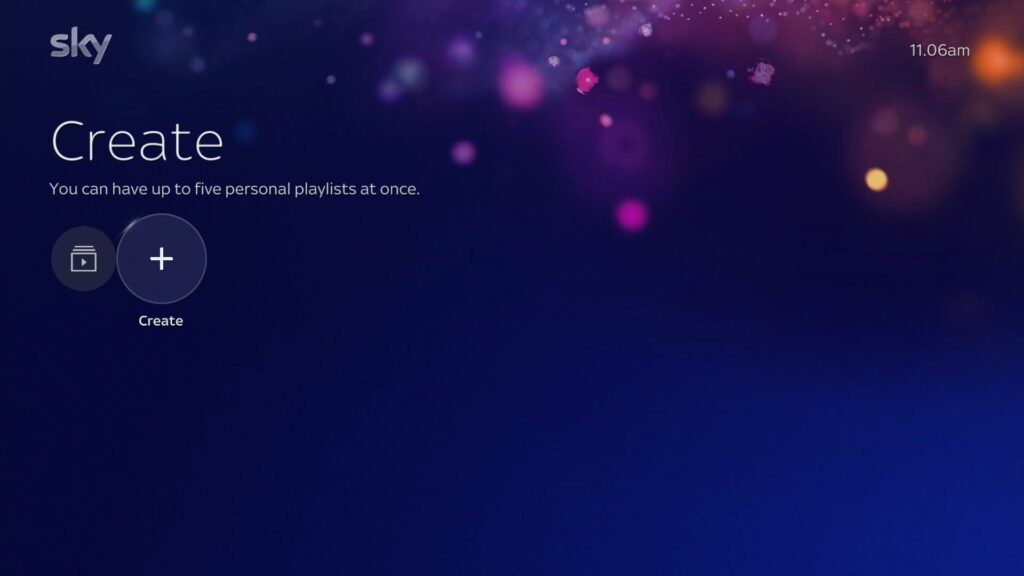
Features
- Playlist keeps track of your viewing habits
- Voice support well integrated
- Playlist ‘saves’ rather than records content
As with Sky Glass, Playlist is the rug that nits Entertainment OS together. Sky refers to Playlist as cloud DVR, but you can’t record content only ‘save’ titles to the cloud by pressing the ‘+’ button on the remote.
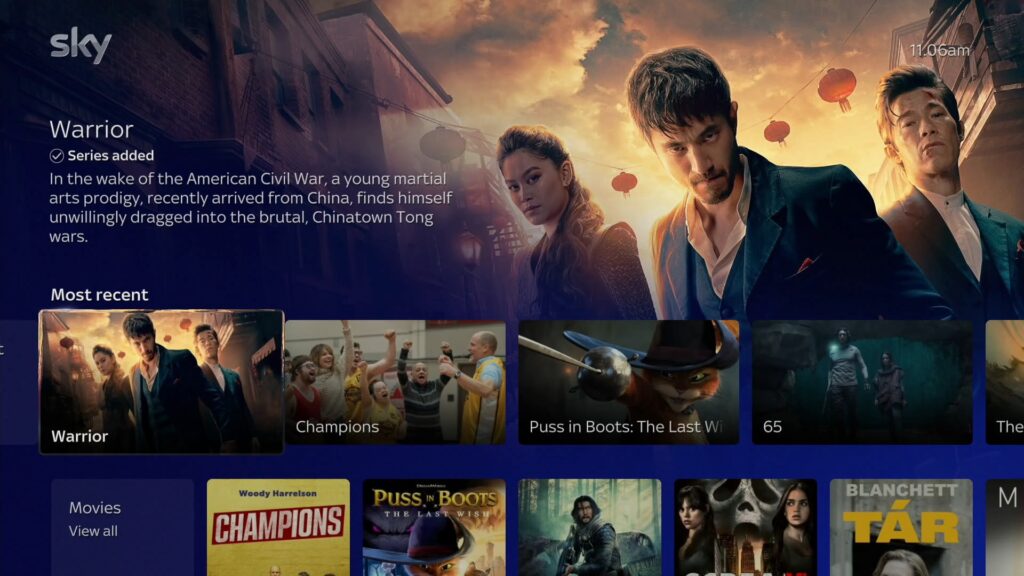
The lack of recording is likely to be troublesome to those who prefer to keep hold of programmes for a while longer. For instance, if a title you’ve saved has left Prime Video, you’d lose access to it in Playlist. If it pops up elsewhere, you’d need to be a subscriber to that service to watch it again; or if it pops up in the Sky Store, you’ll have to pay for it. If content is subject to rights issues – say Match of the Day or live sports – it’ll eventually disappear too.
Despite that, I like how Playlist functions. It works better if you have multiple subscriptions and keeping track of titles you want to watch is straightforward, separated into ‘Most recent’, ‘Movies’ ‘Sports’ and ‘TV series’.
You can’t add content to Playlist from within an app, so to add to it you’ll have to search for programmes. Add a TV series and all seasons are collected, and if seasons are missing the Sky Store can pick up the slack. I was watching Spider-Man: No Way Home on Sky and it doesn’t appear to be available anymore, so it switched to No Way Home on Netflix instead
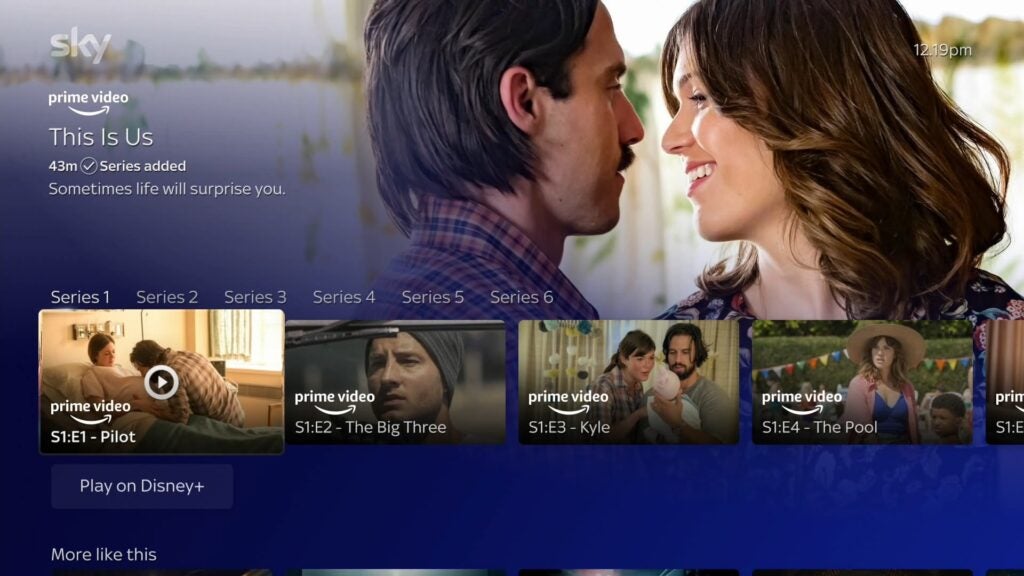
What methodology Sky uses to present results on titles available across multiple services is unclear. For instance, This Is Us is on Prime Video and Disney+, but search for it and it’ll initially come up as a Prime Video title. Scroll down and under each episode is a button where you can watch it on other services (in this case Disney+). Perhaps that’s an area to tweak to make it clearer in case viewers don’t have a subscription for one service but do for other.
Voice support is available for general search and has also been added to YouTube and Netflix (Sky has said voice search will be coming to more apps down the line).
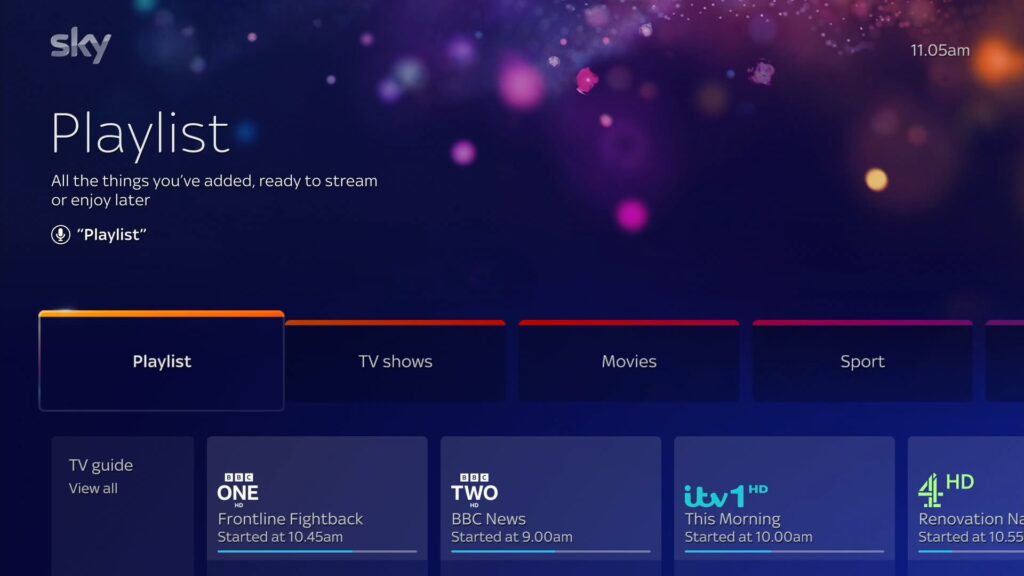
The remote is the same as Sky Glass, although it appears it’s only available in a black finish for the Stream. Backlit buttons help in darker rooms and ergonomically it’s fine – the D-pad offers decent responsiveness and it’s not too crowded with buttons.
Some online forums have mentioned issues with its Bluetooth connection, but the only issue I’ve had is when the batteries died and the remote went out of sync, although the Stream’s error messages weren’t too helpful in figuring out the issue.
Performance
- Very good picture across HD and 4K HDR
- Speedy buffering times
- Navigation not always the fastest
As ever with streaming devices, it’s getting difficult to tell much of a difference in picture quality terms. They all hit a similar level of performance, and picture quality across HD and 4K resolutions with the Sky Stream is excellent – but the caveat here is that like all streamers, the performance depends on how good your TV is.
The Sky Stream supports HDR10, HLG and Dolby Vision but leaves HDR10+ on the side-lines. Prime Video is the biggest app that supports HDR10+, but it does also support Dolby Vision with several titles.
That means for those with compatible Panasonic, Philips and Samsung TVs, you’ll be missing out on the extra refinement and tailoring to a display that HDR10+ can offer if the puck supported it.

In any case the Stream’s picture quality impresses. There are high levels of detail and sharpness where required, plus satisfying clarity and strong colours watching the likes of Girls (HD), Formula 1, House of the Dragon, and Ambulance (4K HDR), though that’s dependent on your TV’s performance.
What I think matters most is buffering, and the Sky Stream puck is robust in terms of stability over Wi-Fi. Stuttering was an issue after pausing content for a few minutes and resuming, but that’s been resolved. I haven’t encountered any static images mentioned online, though there was some audio distortion watching The Resort, NFL, and streaming music through my sound system. With another sound system (and through the TV) I haven’t had any other issues.

Voice control is getting better at recognising what you’re saying and fetching results. Stress testing it with Andor (which seems to be a difficult word for voice support to recognize) it came up with ‘And or’ (in some cases ‘Ando’), with all sorts of results, including, amusingly, Harry Potter and the Order of the Phoenix. Saying ‘Star Wars Andor’ finally sealed it.
Sometimes it won’t recognise what I’m saying. It seems to have trouble recognising how I pronounce Dragon, confusing it with ‘Day’ and in some weird cases ‘Beau’.
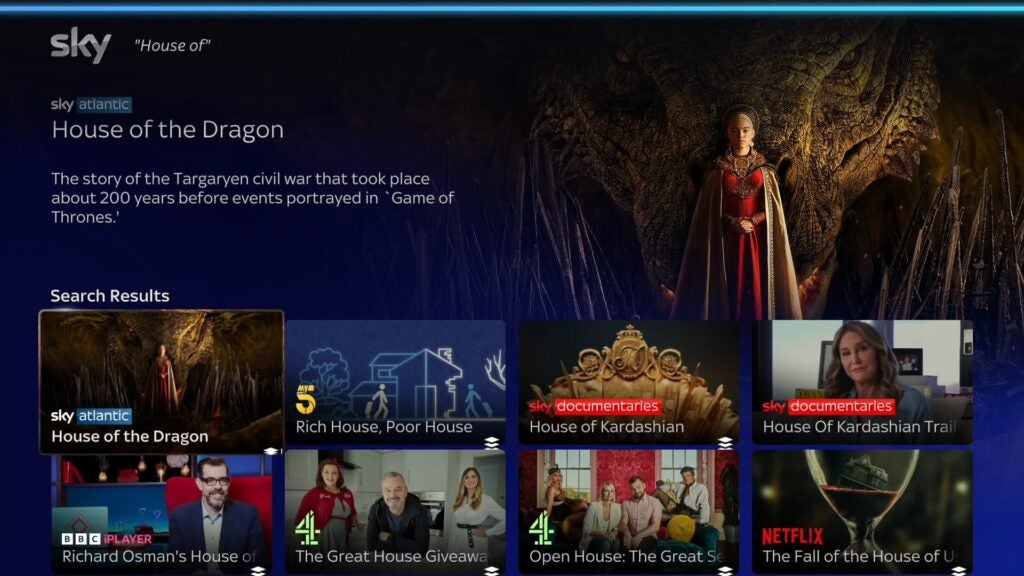
In terms of speed, I’d say Sky Glass is slightly quicker; whether scrolling through the menus or loading apps. Compare it to the Fire TV Cube (2022) and whether it’s navigation or fetching results, Amazon’s streamer is absolutely rapid.
Scrubbing through TV episodes and films presents no issues, you can see the resolution and sharpness drop but it jumps back to normal when playback is resumed.
It should be noted that for the 4K UHD and Dolby Atmos pack the minimum download speed is 25Mbps. Minimum bandwidth required for a single puck is 10Mb/s, and for multiple pucks, you’ll need more bandwidth available.
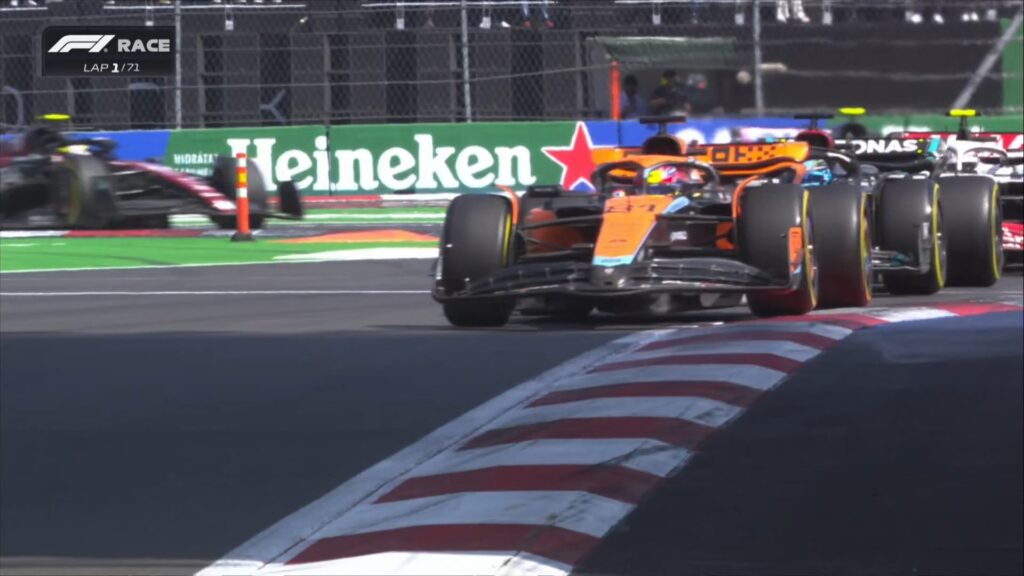
On the audio front there’s support for Dolby Atmos and I can’t hear a difference between the puck and the Fire TV Cube (2022) watching The Tomorrow War on Prime Video. The scene where the conscripts jump into the future is presented with powerful bass, elevated sound effects (when the electricity field comes on), and plenty of activity in the surrounds. The performance on both streamers is pretty much the same.
With music there’s a difference. With The Preatures’ Is This How You Feel? Streaming from Spotify, the Stream puck gets stuck into the bass more than the Fire TV Cube, as well as producing a slightly echoey tone with vocals. The Stream puck sounds bolder and livelier, but to my ears the Fire TV Cube is clearer, sharper at the top end of the frequency range and better balanced overall.
Latest deals
Latest deals
The Sky Stream is now available from £26 per month at Sky
Save money with Trusted Reviews vouchers
Fancy getting a major discount on some of the biggest Sky products currently available? Then you’ll be pleased to know that our team has secured numerous vouchers and promo codes from Sky, all in the name of saving you money.
Should you buy it?
If you want TV and films served up to you on a platter
The Entertainment OS curates content in an excellent manner, treating all content from whatever service fairly.
The costs are too much
In this cost-of-living age, 4K, HDR and Dolby Atmos add-ons as well as adding more bundles like sports makes the Stream very expensive
Final Thoughts
With the Stream puck, Sky has presented an accessible and easily navigable interface. Content discovery is excellent, producing a platform agnostic streamer in a similar mould to Roku. The more I use Playlist the more I like it.
It’s an excellent streamer for Sky customers who don’t need nor want the Glass TV, and it’s a great entry-level path into the Sky ecosystem. For all the bells and whistles, the costs rack up. For UHD, Atmos, Sky Cinema, Sky Sports, Netflix Premium, and ad skipping, it’s £74/month for, and that’s before you add subscriptions to other streaming services.
Getting the most out of Sky Stream requires a significant investment, but there’s plenty to sink your time into with the Stream. The content is the star of the show, and now you can plug it into whatever screen you prefer.
How we test
We test every video streamer we review thoroughly over an extended period of time. We use industry-standard tests to compare features properly. We’ll always tell you what we find. We never, ever, accept money to review a product.
Find out more about how we test in our ethics policy
Tested across several months
Tested with real world use
FAQs
The Stream is compatible with any broadband provider. All you need to make sure of is that you have a minimum speed of 10Mb/s. Add more pucks and you’ll need more bandwidth.
Jargon buster
HDR
HDR stands for High Dynamic Range and refers to contrast (or difference) between the brightest and darkest parts of an image. HDR content preserves details in the darkest and brightest areas of a picture, details that are often lost in old imaging standards. HDR10 is mandated to be included on all HDR TVs. It’s also supported by 4K projectors.
Dolby Vision
Dolby Vision is a variant of HDR, adding a layer of dynamic metadata to the core HDR signal. This dynamic metadata carries scene-by-scene (or frame-by-frame) instructions from content creators on how a TV should present the images to improve everything from brightness to contrast, detailing and colour reproduction.
Verdict
An excellent premium streamer from Sky that puts content at the core of its offering. That content is pricey, but no other broadcaster offers a broad a church as Sky does with its entertainment options.
Pros
- Democratic approach to content discovery
- Accessible interface
- Dolby Vision and Atmos support
- Stable streaming performance
Cons
- Costs add up with add-ons
- Additional pucks eat up more bandwidth
- Interface is a little sluggish at times
-
HDRHDR10, Dolby Vision and HLG -
Entertainment OSSky’s interface for curating content across services -
AudioDolby Atmos support
Introduction
First it was all about the box beneath your TV screen, then it became an actual TV and now it’s completed another transformation into a puck, with the Sky Stream presented as a standalone streamer.
Initially, the Stream puck was only available as an accessory to the Sky Glass TV, but it’s since been liberated, purchasable on its own and it’s arguably one of the wisest moves Sky has made.
Sky Glass has been a success among more casual TV viewers, but it’s not perfect. With the Stream, it allows customers who don’t need a new TV a ‘just-add’ device, bringing the same content you’d find on Sky Q and Glass in a more accessible and convenient form. It comes with a premium price tag, but if you can afford all the trimmings, this is a great pathway into the world of entertainment Sky offers.
Availability
Offers for Sky Stream change throughout the year. Often, it’s a choice of 18-month contract with prices hovering between £24- and £26/month. That promotion entitles you to the puck, Sky TV and Netflix Basic as standard.
Another option is the ‘flexible’ 31-day rolling contract that can be cancelled at any time. Prices for that tend be higher at £29/month.
As of November 2023, there’s a deal that guarantees a 1-month free trial on both contract terms, and thereafter it bumps up to the usual prices for £26/month on the 18-month and £29/month for the rolling contracts.
You can choose from several bundles on a fixed basis or rolling contract and further modify it with add-on packs and services. For instance, the UHD/Dolby Atmos pack it is a rolling £6/month, TNT Sports is currently £28/month, and Sky Sports is currently £20/month on a 18-month contract.
For the Whole Home pack, it’s an extra £12/month that allows access to five additional Stream devices (the second puck is free). Some bundles have no set-up costs, others incur a £20 set-up fee on an 18-month contract.
Design
- HDMI cable included
- HDMI 2.1 port
- Doesn’t require line of sight for remote
The Sky Stream puck’s black finish and square shape with rounded corners is both a discreet and space saving design. Even more helpful is that it doesn’t require line-of-sight so you could happily place it behind a TV and still operated it.
It looks not unlike the Mi Box S and Strong Leap-S1 in shape and size but has fewer connection options than either. Around the back is an HDMI 2.1 input (a cable is packaged), an Ethernet port and an aerial tuner, the only real use for the latter is as backup for a TV signal if the internet goes down.

Sky is a closed system and doesn’t offer the connectivity options that Android and (some) Fire TV streamers do. There’s no ability to hook directly to a sound system, connect a hard drive or plug a pair of wired headphones if you so choose. HDMI CEC support means control of volume on a soundbar/TV, and that can be done in the initial set-up process or later in the Stream’s menus.

Interface and apps
- Smaller selection of apps compared to Fire TV, Roku
- Seamless resumption across multiple pucks
- Coherent and well-laid out interface
Sky calls the interface for both its Stream and Glass devices ‘Entertainment OS’. It aggregates all of Sky’s content alongside that from other providers such as BBC iPlayer, Netflix and Disney+. I find it a much more democratic interface than Amazon’s Fire TV as it doesn’t outright favour Sky over others.
At the top of the screen are Top Picks, followed by a rail divided into sections (Playlist, TV Shows, Movies, Sport, Kids, Audio and Music, News, Fitness and International). Dive into each section and you’ll find content listed in rows and TV guides specific to each one.

Playlist is ordered by ‘most recent’, so new and current episodes/shows show up first. I’d prefer the Continue Watching rail to be the next one down from Top picks and the content section rails rather than having to scroll down for it, but otherwise the interface is all coherently laid out and easy to grasp with straightforward navigation.
Watch something and return to the home screen and content keeps playing in a pop-up video in the Top Pick rail, so you can return to it without pausing. If you have multiple pucks, content is synchronized so you can jump from your living room to your bedroom, and resume where you left off.
In terms of apps, there isn’t as big a selection as on Android/Google, Roku, or Fire TV, but the argument could be made about quality over quantity. Nevertheless, small apps like Mubi and Curzon aren’t present but all the main UK catch-up apps are present.

You can count on most of the big, popular apps to be there, as well as ITVX, All4, YouTube, and bulked up by Lionsgate+, Apple TV+, Spotify, Peloton and more. Paramount+, Peacock and Discovery+ are included for those with Sky Cinema and TV subscriptions.
If there’s an obvious area where Sky is missing apps, it’s sports – no individual TNT Sport, UFC, WWE, NFL, or Eurosport apps, though either a Sky Sports or TNT Sports sub would cover these. The other is music, with no Tidal, Deezer or Apple Music.
Unlike Fire TV and Google TV, Sky has opted not to include individual profiles. Instead, up to five ‘personal’ playlists can be created, acting as ‘profiles’ for family members.

Features
- Playlist keeps track of your viewing habits
- Voice support well integrated
- Playlist ‘saves’ rather than records content
As with Sky Glass, Playlist is the rug that nits Entertainment OS together. Sky refers to Playlist as cloud DVR, but you can’t record content only ‘save’ titles to the cloud by pressing the ‘+’ button on the remote.

The lack of recording is likely to be troublesome to those who prefer to keep hold of programmes for a while longer. For instance, if a title you’ve saved has left Prime Video, you’d lose access to it in Playlist. If it pops up elsewhere, you’d need to be a subscriber to that service to watch it again; or if it pops up in the Sky Store, you’ll have to pay for it. If content is subject to rights issues – say Match of the Day or live sports – it’ll eventually disappear too.
Despite that, I like how Playlist functions. It works better if you have multiple subscriptions and keeping track of titles you want to watch is straightforward, separated into ‘Most recent’, ‘Movies’ ‘Sports’ and ‘TV series’.
You can’t add content to Playlist from within an app, so to add to it you’ll have to search for programmes. Add a TV series and all seasons are collected, and if seasons are missing the Sky Store can pick up the slack. I was watching Spider-Man: No Way Home on Sky and it doesn’t appear to be available anymore, so it switched to No Way Home on Netflix instead

What methodology Sky uses to present results on titles available across multiple services is unclear. For instance, This Is Us is on Prime Video and Disney+, but search for it and it’ll initially come up as a Prime Video title. Scroll down and under each episode is a button where you can watch it on other services (in this case Disney+). Perhaps that’s an area to tweak to make it clearer in case viewers don’t have a subscription for one service but do for other.
Voice support is available for general search and has also been added to YouTube and Netflix (Sky has said voice search will be coming to more apps down the line).

The remote is the same as Sky Glass, although it appears it’s only available in a black finish for the Stream. Backlit buttons help in darker rooms and ergonomically it’s fine – the D-pad offers decent responsiveness and it’s not too crowded with buttons.
Some online forums have mentioned issues with its Bluetooth connection, but the only issue I’ve had is when the batteries died and the remote went out of sync, although the Stream’s error messages weren’t too helpful in figuring out the issue.
Performance
- Very good picture across HD and 4K HDR
- Speedy buffering times
- Navigation not always the fastest
As ever with streaming devices, it’s getting difficult to tell much of a difference in picture quality terms. They all hit a similar level of performance, and picture quality across HD and 4K resolutions with the Sky Stream is excellent – but the caveat here is that like all streamers, the performance depends on how good your TV is.
The Sky Stream supports HDR10, HLG and Dolby Vision but leaves HDR10+ on the side-lines. Prime Video is the biggest app that supports HDR10+, but it does also support Dolby Vision with several titles.
That means for those with compatible Panasonic, Philips and Samsung TVs, you’ll be missing out on the extra refinement and tailoring to a display that HDR10+ can offer if the puck supported it.

In any case the Stream’s picture quality impresses. There are high levels of detail and sharpness where required, plus satisfying clarity and strong colours watching the likes of Girls (HD), Formula 1, House of the Dragon, and Ambulance (4K HDR), though that’s dependent on your TV’s performance.
What I think matters most is buffering, and the Sky Stream puck is robust in terms of stability over Wi-Fi. Stuttering was an issue after pausing content for a few minutes and resuming, but that’s been resolved. I haven’t encountered any static images mentioned online, though there was some audio distortion watching The Resort, NFL, and streaming music through my sound system. With another sound system (and through the TV) I haven’t had any other issues.

Voice control is getting better at recognising what you’re saying and fetching results. Stress testing it with Andor (which seems to be a difficult word for voice support to recognize) it came up with ‘And or’ (in some cases ‘Ando’), with all sorts of results, including, amusingly, Harry Potter and the Order of the Phoenix. Saying ‘Star Wars Andor’ finally sealed it.
Sometimes it won’t recognise what I’m saying. It seems to have trouble recognising how I pronounce Dragon, confusing it with ‘Day’ and in some weird cases ‘Beau’.

In terms of speed, I’d say Sky Glass is slightly quicker; whether scrolling through the menus or loading apps. Compare it to the Fire TV Cube (2022) and whether it’s navigation or fetching results, Amazon’s streamer is absolutely rapid.
Scrubbing through TV episodes and films presents no issues, you can see the resolution and sharpness drop but it jumps back to normal when playback is resumed.
It should be noted that for the 4K UHD and Dolby Atmos pack the minimum download speed is 25Mbps. Minimum bandwidth required for a single puck is 10Mb/s, and for multiple pucks, you’ll need more bandwidth available.

On the audio front there’s support for Dolby Atmos and I can’t hear a difference between the puck and the Fire TV Cube (2022) watching The Tomorrow War on Prime Video. The scene where the conscripts jump into the future is presented with powerful bass, elevated sound effects (when the electricity field comes on), and plenty of activity in the surrounds. The performance on both streamers is pretty much the same.
With music there’s a difference. With The Preatures’ Is This How You Feel? Streaming from Spotify, the Stream puck gets stuck into the bass more than the Fire TV Cube, as well as producing a slightly echoey tone with vocals. The Stream puck sounds bolder and livelier, but to my ears the Fire TV Cube is clearer, sharper at the top end of the frequency range and better balanced overall.
Latest deals
Latest deals
The Sky Stream is now available from £26 per month at Sky
Save money with Trusted Reviews vouchers
Fancy getting a major discount on some of the biggest Sky products currently available? Then you’ll be pleased to know that our team has secured numerous vouchers and promo codes from Sky, all in the name of saving you money.
Should you buy it?
If you want TV and films served up to you on a platter
The Entertainment OS curates content in an excellent manner, treating all content from whatever service fairly.
The costs are too much
In this cost-of-living age, 4K, HDR and Dolby Atmos add-ons as well as adding more bundles like sports makes the Stream very expensive
Final Thoughts
With the Stream puck, Sky has presented an accessible and easily navigable interface. Content discovery is excellent, producing a platform agnostic streamer in a similar mould to Roku. The more I use Playlist the more I like it.
It’s an excellent streamer for Sky customers who don’t need nor want the Glass TV, and it’s a great entry-level path into the Sky ecosystem. For all the bells and whistles, the costs rack up. For UHD, Atmos, Sky Cinema, Sky Sports, Netflix Premium, and ad skipping, it’s £74/month for, and that’s before you add subscriptions to other streaming services.
Getting the most out of Sky Stream requires a significant investment, but there’s plenty to sink your time into with the Stream. The content is the star of the show, and now you can plug it into whatever screen you prefer.
How we test
We test every video streamer we review thoroughly over an extended period of time. We use industry-standard tests to compare features properly. We’ll always tell you what we find. We never, ever, accept money to review a product.
Find out more about how we test in our ethics policy
Tested across several months
Tested with real world use
FAQs
The Stream is compatible with any broadband provider. All you need to make sure of is that you have a minimum speed of 10Mb/s. Add more pucks and you’ll need more bandwidth.
Jargon buster
HDR
HDR stands for High Dynamic Range and refers to contrast (or difference) between the brightest and darkest parts of an image. HDR content preserves details in the darkest and brightest areas of a picture, details that are often lost in old imaging standards. HDR10 is mandated to be included on all HDR TVs. It’s also supported by 4K projectors.
Dolby Vision
Dolby Vision is a variant of HDR, adding a layer of dynamic metadata to the core HDR signal. This dynamic metadata carries scene-by-scene (or frame-by-frame) instructions from content creators on how a TV should present the images to improve everything from brightness to contrast, detailing and colour reproduction.



















